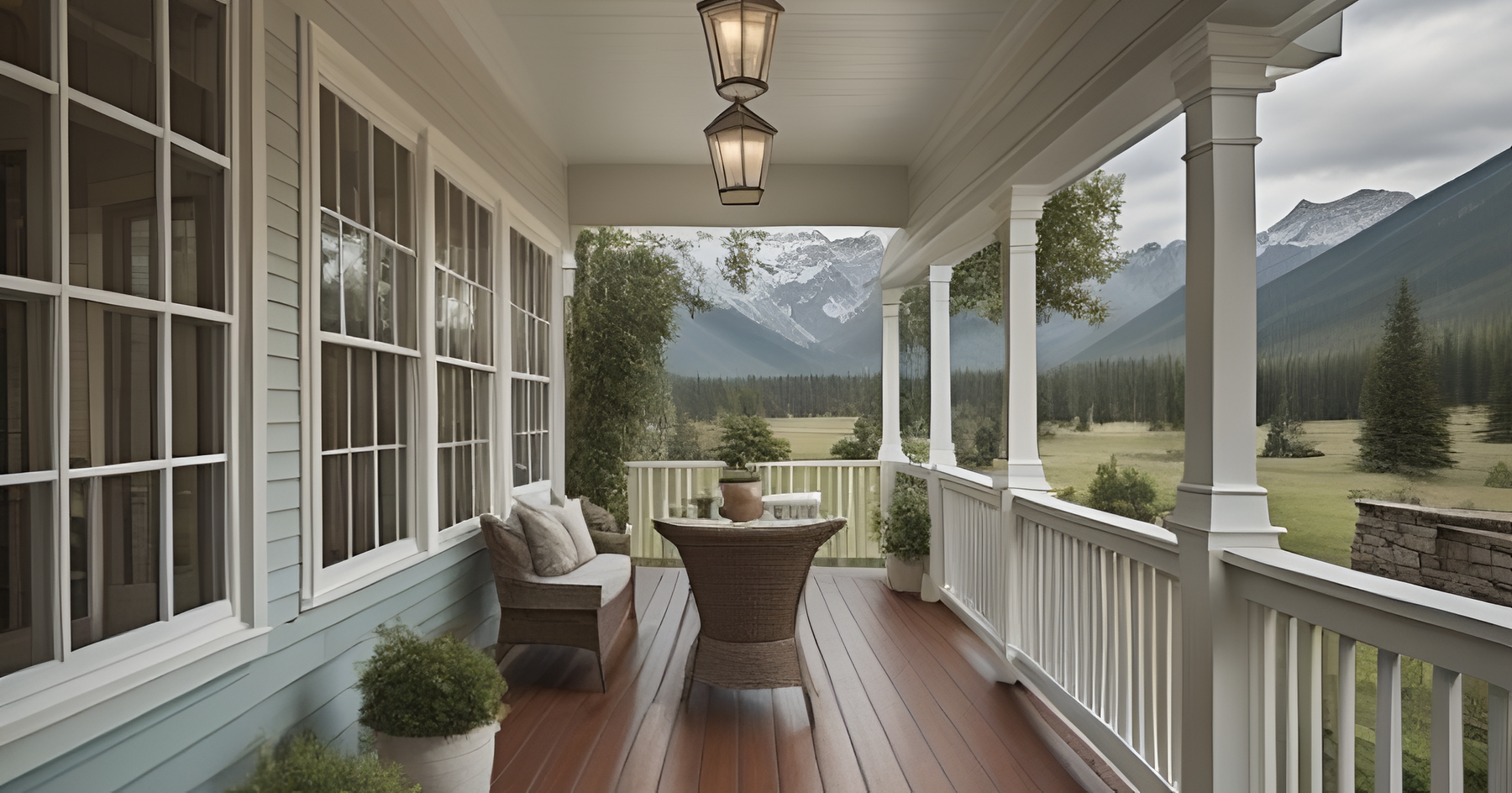
Exploring Outdoor Living: What is a Veranda?
Welcome to our guide on outdoor living! In this article, we will dive into the world of verandas and uncover their significance in creating a beautiful outdoor space. If you've ever wondered what exactly a veranda is, or if you're seeking inspiration for your own veranda design, you've come to the right place.
So, what is a veranda? A veranda is a covered, open-air structure that is typically attached to the main building, extending from the façade. It provides a sheltered space and acts as an extension of your living area, blurring the boundaries between your indoor and outdoor spaces.
Verandas have been an integral part of architecture for centuries, with their origins dating back to ancient civilizations. Over time, they have evolved in design and purpose, becoming a sought-after addition to contemporary homes. Today, verandas offer a versatile and stylish way to enhance your outdoor living experience.

Key Takeaways:
- A veranda is a covered, open-air structure attached to the main building.
- It extends from the façade and provides a sheltered space.
- Verandas blur the boundaries between indoor and outdoor living.
- They have a rich history and have evolved in design and purpose.
- Verandas offer a versatile and stylish way to enhance outdoor living.
Types of Verandas and Veranda Design Ideas
In this section, we will explore the different types of verandas available, along with a wide range of veranda design ideas. Whether you're envisioning a classic and elegant veranda or a contemporary and sleek design, we've got you covered with inspirational suggestions to bring your veranda dreams to life.
1. Traditional Verandas:
Traditional verandas have been an integral part of architectural design across various historical periods and styles. Here's a breakdown of traditional veranda styles:
Victorian Verandas:
- Victorian architecture, popular during the reign of Queen Victoria (1837-1901), often featured ornate and decorative elements.
- Victorian verandas typically have intricate wrought iron or wooden detailing, including scrollwork, balusters, and decorative brackets.
- These verandas were often prominent features of grand Victorian homes, extending along the front or sides of the house, providing a shaded outdoor space.
Colonial Verandas:
- Colonial architecture, influenced by European styles during the colonial period of a country, often emphasizes symmetry and simplicity.
- Colonial verandas are characterised by their straightforward design, with simple columns or pillars supporting a roof structure.
- These verandas were common in colonial-style homes, providing a functional outdoor space for relaxation and socialization.
Country-style Verandas:
- Country or farmhouse style architecture is known for its rustic charm and relaxed atmosphere.
- Country-style verandas typically feature wide, inviting spaces with natural materials such as wood or stone.
- These verandas often have a cosy, informal feel, with elements like rocking chairs, porch swings, and potted plants adding to their charm.
Each of these traditional veranda styles reflects the architectural preferences and cultural influences of their respective time periods and regions, while still providing a welcoming outdoor space for occupants to enjoy.

2. Modern Verandas:
Modern verandas often reflect contemporary design trends and architectural styles, emphasizing clean lines, simplicity, and functionality. Here are three modern veranda styles:
Minimalist Verandas:
- Minimalist design focuses on simplicity and functionality, often using clean lines, open spaces, and a limited color palette.
- Minimalist verandas typically feature sleek and understated structures with simple geometric forms.
- Materials like steel, glass, and concrete are commonly used to create minimalist verandas, emphasizing a sense of openness and lightness.
Contemporary Verandas:
- Contemporary design incorporates elements of various styles, blending traditional and modern influences to create a unique aesthetic.
- Contemporary verandas often feature a mix of materials, textures, and finishes, such as wood, metal, and stone, creating visual interest.
- These verandas may include innovative design features like retractable awnings, integrated lighting, or sustainable elements like green roofs or solar panels.
Architectural Verandas:
- Architectural verandas are characterized by their design sophistication and attention to detail, often serving as focal points of modern buildings.
- These verandas may incorporate architectural elements such as cantilevered structures, asymmetrical forms, or dynamic rooflines.
- Architectural verandas often prioritise both aesthetics and functionality, seamlessly integrating with the overall design of the building while providing an inviting outdoor space.
If you prefer a sleek and clean aesthetic, explore the possibilities of a minimalist veranda design. For a more avant-garde approach, contemporary verandas offer innovative features and modern materials. Architectural verandas push the boundaries of design and create a striking focal point for your outdoor space.

3. Multi-Purpose Verandas:
Multi-purpose verandas are designed to accommodate various activities and functions, serving as versatile outdoor living spaces. Here are three common types of multi-purpose verandas:
Entertainment Verandas:
- Entertainment verandas are designed for hosting gatherings, parties, and social events.
- These verandas often feature amenities such as built-in seating areas, outdoor kitchens, barbecue grills, and fire pits.
- Entertainment verandas may include features like integrated sound systems, outdoor TVs, and ambient lighting to create an inviting atmosphere for guests.
Outdoor Dining Verandas:
- Outdoor dining verandas are specifically tailored for enjoying meals alfresco.
- These verandas typically include a dining table or seating area large enough to accommodate family and guests.
- Outdoor dining verandas may feature amenities such as built-in grills or pizza ovens, overhead pergolas or umbrellas for shade, and ambient lighting for evening meals.
Relaxation Verandas:
- Relaxation verandas are designed to provide a tranquil retreat for rest and relaxation.
- These verandas often feature comfortable seating options such as lounge chairs, hammocks, or daybeds.
- Relaxation verandas may incorporate natural elements such as water features, lush landscaping, and aromatic plants to create a serene atmosphere.
Make your veranda a versatile space that caters to your specific needs. An entertainment veranda can be equipped with outdoor speakers and a cosy seating area for hosting gatherings. If you enjoy al fresco dining, an outdoor dining veranda with a stylish table and chairs is perfect. For those seeking a peaceful retreat, a relaxation veranda adorned with comfortable lounge furniture and lush greenery is the ultimate oasis.
When designing your veranda, consider incorporating elements like:
- Pergolas and Canopies
- Outdoor Lighting
- Greenery and Planters
- Outdoor Fireplaces
- Water Features
These additions can enhance the functionality, ambiance, and visual appeal of your veranda.
With the variety of veranda types and design ideas available, you can create a space that reflects your personal style and enhances your outdoor living experience. Let your imagination run wild, and transform your veranda into a captivating extension of your home.
Veranda vs Porch: A Comparison
When it comes to outdoor living spaces, two popular options that often come to mind are verandas and porches. While both provide a sheltered area to enjoy the fresh air and connect with nature, they have distinct characteristics that set them apart. Let's explore the differences and similarities between verandas and porches to help you better understand which option suits your needs.
A veranda, also known as a covered terrace, is an open-air space typically attached to the main building. It often extends from the ground floor, allowing for a seamless transition between indoor and outdoor living. Verandas are commonly designed with a roof, columns, and railings, offering a sense of elegance and sophistication. They are perfect for relaxing, entertaining guests, or simply lounging in comfort and style.

In contrast, a porch is an enclosed or partially covered space located at the entrance of a building. It serves as a protected area, creating a buffer between the indoors and outdoors. Porches can be found in various architectural styles, such as farmhouse, Victorian, or colonial, each showcasing unique charm and character. They provide a cosy spot to welcome guests, enjoy a morning cup of tea, or watch the world go by.
So, what sets verandas and porches apart? While both offer sheltered outdoor spaces, verandas are typically larger in size and serve as an extension of the living area. They often wrap around the building, providing ample space for multiple activities and furniture arrangements. Porches, on the other hand, tend to be smaller and more intimately connected to the entrance of the house.
Conclusion
In summary, verandas are essential elements of outdoor living, seamlessly blending indoor and outdoor spaces while offering shelter and style. From traditional to modern designs, verandas cater to various preferences, providing versatile spaces for entertainment, dining, and relaxation.
By incorporating elements like pergolas and outdoor lighting, homeowners can enhance their verandas' functionality and aesthetic appeal, creating inviting environments for enjoying the outdoors.
Whether opting for a veranda or porch, both offer sheltered areas for relaxation and socialization, with verandas typically providing larger, more adaptable spaces. In essence, verandas enrich outdoor living, transforming spaces into captivating extensions of the home.
Other content you'll love:
Veranda vs Conservatory: Key Differences
Veranda Cost Guide: Plan Your Budget Smartly
Step-by-Step Guide on How Build Veranda
Porch vs Veranda: Spot the Difference!
Polycarbonate vs Glass: Best Veranda Roof Choice
Lean to Veranda Explained – Enhance Outdoor Living
Install a Glass Veranda on Your Patio? Find Out!
Glass Sided Verandas: Can They Be a Reality?
Glass Room Comfort: Explaining the Warmth of a Glass Room


